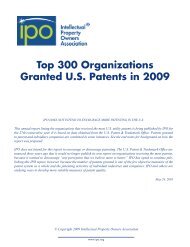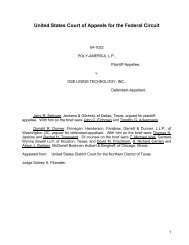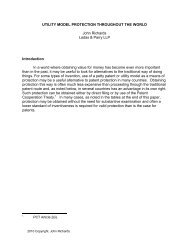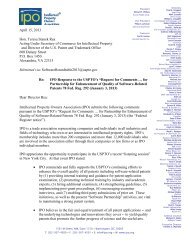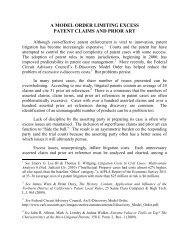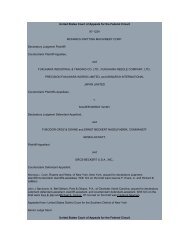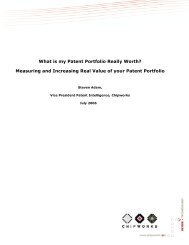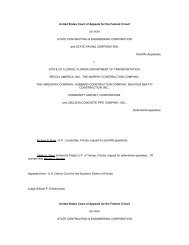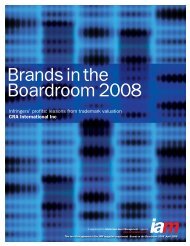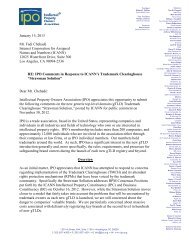Ruiz v. A.B. Chance Co.
Ruiz v. A.B. Chance Co.
Ruiz v. A.B. Chance Co.
Create successful ePaper yourself
Turn your PDF publications into a flip-book with our unique Google optimized e-Paper software.
The district court defined the person of ordinary skill in the art to be someone skilled in the art of foundation<br />
underpinnings. The determination of the level of ordinary skill in the art is an integral part of<br />
the Graham analysis. See Custom Accessories, 807 F.2d. at 962, 1 USPQ2d at 1201 ("Without [a<br />
determination of the level of ordinary skill in the art], a district court cannot properly assess obviousness<br />
because the critical question is whether a claimed invention would have been obvious at the time it was<br />
made to one with ordinary skill in the art.") (internal citation omitted). Factors that may be considered in<br />
determining the ordinary level of skill in the art include: 1) the types of problems encountered in the art; 2)<br />
the prior art solutions to those problems; 3) the rapidity with which innovations are made; 4) the<br />
sophistication of the technology; and 5) the educational level of active workers in the field. See id. at 962, 1<br />
USPQ2d at 1201 (citing Envtl. Designs, Ltd. v. Union Oil <strong>Co</strong>., 713 F.2d 693, 697, 218 USPQ 865, 868-69<br />
(Fed. Cir. 1983)). "Not all such factors may be present in every case, and one or more of them may<br />
predominate." Id. Some of our cases indicate that the failure to make explicit findings on the level of ordinary<br />
skill is not always reversible error. See, e.g., Kloster Speedsteel AB v. Crucible Inc., 793 F.2d 1565, 1574, 230<br />
USPQ 81, 86 (Fed. Cir. 1986); Union Carbide <strong>Co</strong>rp. v. American Can <strong>Co</strong>., 724 F.2d 1567, 1573, 220 USPQ<br />
584, 589 (Fed. Cir. 1984); Chore-Time Equip., Inc. v. Cumberland <strong>Co</strong>rp., 713 F.2d 774, 779 n.2, 218 USPQ<br />
673, 676 n.2 (Fed. Cir. 1983). However, as we noted in Custom Accessories, in those cases, "it was not<br />
shown that the failure to make a finding or an incorrect finding on level of skill influenced the ultimate<br />
conclusion under section 103 and, hence, constituted reversible error." Custom Accessories, 807 F.2d at 963,<br />
1 USPQ2d at 1201.<br />
It is disputed whether <strong>Ruiz</strong> and Fasteel offered clear and convincing evidence that others of ordinary skill in<br />
the art would have thought the <strong>Chance</strong> inventions obvious. Robert Jones, a distributor for <strong>Chance</strong>, testified<br />
that he first used a metal bracket with a screw anchor in a "tie-back" or lateral retention in October or<br />
November 1989. However, Jones also testified that he possessed "greater than ordinary skill in the art,"<br />
since he had been building and designing steel load transfer hardware for over thirty years. Without a more<br />
specific finding of what the level of ordinary skill in the art is, the district court cannot adequately determine<br />
whether Jones’ testimony would support a finding of obviousness.<br />
Accordingly, on remand, while "we do not reverse or vacate solely because of a failure to make the level of<br />
skill finding," we do "consider the district court’s failure to make that and other Graham findings as evidence<br />
that Graham was not in fact applied." Id.<br />
3. Secondary <strong>Co</strong>nsiderations<br />
The district court erred in failing to consider, or at least to discuss, evidence of secondary considerations.<br />
Our precedents clearly hold that secondary considerations, when present, must be considered in<br />
determining obviousness. See, e.g.,Loctite, 781 F.2d at 873, 228 USPQ at 98 ("[S]econdary considerations .<br />
. . , when present, must be considered."); Simmons Fastener <strong>Co</strong>rp. v. Ill. Tool Works, Inc., 739 F.2d 1573,<br />
1575, 222 USPQ 744, 746 (Fed. Cir. 1984) ("Only after all evidence of nonobviousness has been<br />
considered can a conclusion on obviousness be reached."); Ashland Oil, Inc. v. Delta Resin & Refractories,<br />
Inc., 776 F.2d 281, 306, 227 USPQ 657, 662 (Fed. Cir. 1985) ("Just as it is legal error for a district court to<br />
fail to consider relevant evidence going to secondary considerations, it may be legal error for a district court<br />
to presuppose that all evidence relating to secondary considerations, when considered with the<br />
other Graham indicia relating to the obviousness/nonobviousness issue, cannot be of sufficient probative<br />
value to elevate the subject matter of the claimed invention to the level of patentable invention."). Indeed,<br />
in Stratoflex, we said:<br />
[E]vidence of secondary considerations may often be the most probative and cogent evidence in the record.<br />
It may often establish that an invention appearing to have been obvious in light of the prior art was not. It is<br />
to be considered as part of all the evidence, not just when the decisionmaker remains in doubt after<br />
reviewing the art.<br />
Stratoflex, 713 F.2d at 1538, 218 USPQ at 879. Such evidence "may be sufficient to overcome a prima facie<br />
case of obviousness." In re Beattie, 974 F.2d 1309, 1313, 24 USPQ2d 1040, 1043 (Fed. Cir.<br />
1992); see also Sibia, 225 F.2d at 1358, 55 USPQ2d at 1933 ("[T]he mere existence of . . . licenses [i.e.,<br />
secondary considerations] is insufficient to overcome the conclusion of obviousness, as based on the<br />
express teachings in the prior art that would have motivated one of ordinary skill to modify . . . cells to be<br />
used with unknown compounds."). Our precedents also establish that failure to cite secondary<br />
considerations, alone, is not reversible error. See Brown & Williamson v. Phillip Morris, 229 F.3d 1120, 1131<br />
(Fed. Cir. 2000) (stating that failure of the district court to consider certain objective evidence of<br />
nonobviousness was harmless error, because it "cannot overcome the strong evidence of<br />
nonobviousness").



